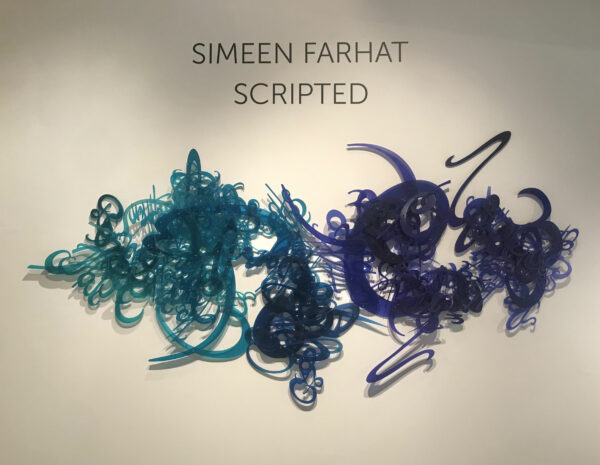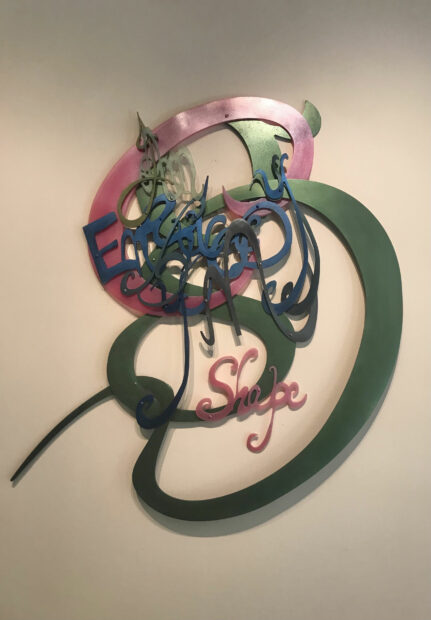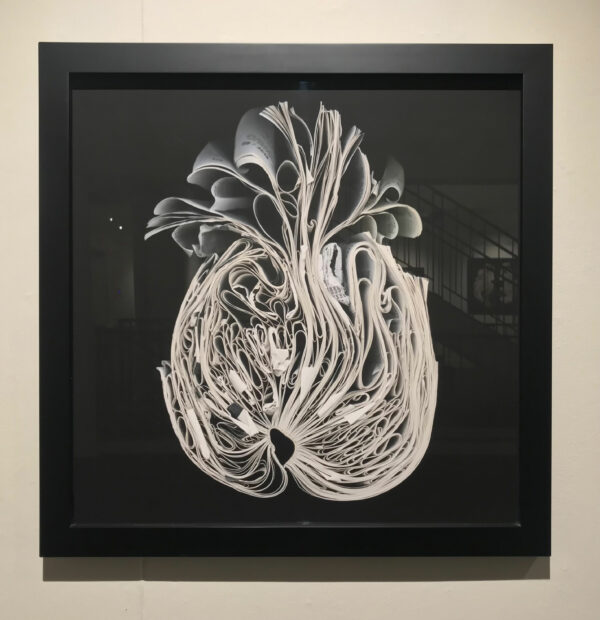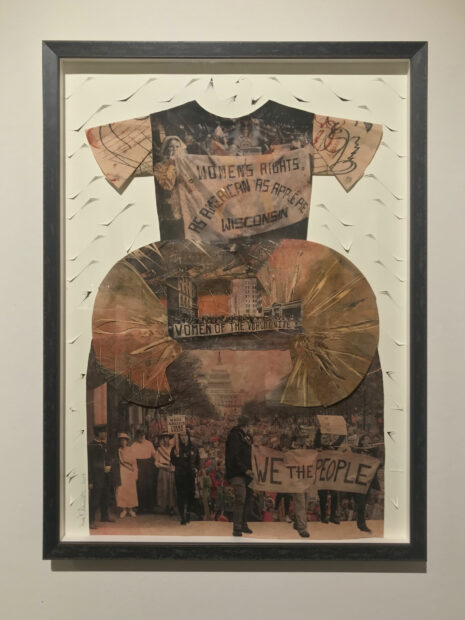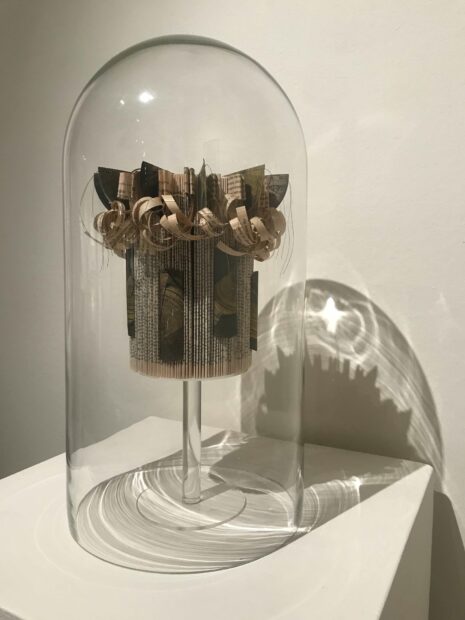
“Ruscha & Roth: The 1960s Artist Book Revolution,” on view at the Grace Museum. Photo by Billi London-Gray
The Grace Museum in Abilene is the place for bibliophiles this summer. Five exhibitions explore relationships between books, text, and visual art. These include solo shows by Texas-based artists Cara Barer, Anna Mavromatis, and Simeen Farhat, as well as a dialectic pairing of artist books by Dieter Roth and Ed Ruscha, amidst artist books and prints from the museum’s permanent collection.
The sequencing of these exhibitions in the museum’s spaces thoughtfully directs reflection on artists’ uses of language and book forms. The historical context and the idea of “conversation” are both established first in a large room dedicated to Roth, Ruscha, and other collected artist books. Further into the museum, the space opens into a bright atrium, where Farhat’s resin sculptures glow. A staircase in the center of the atrium ascends to the galleries with Barer’s photographic prints and Mavromatis’s mixed media pieces, as well as additional language-related works from the permanent collection.
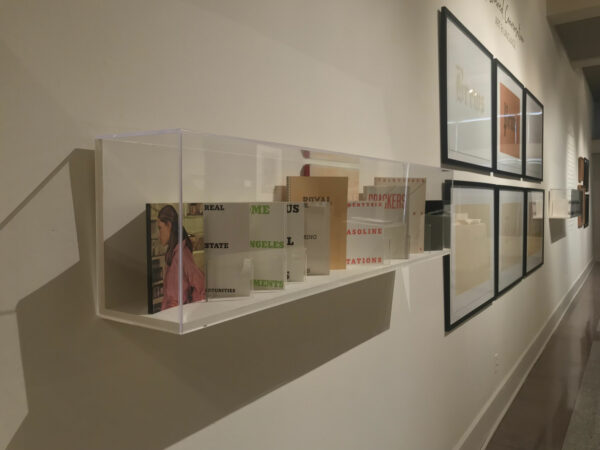
“Ruscha & Roth: The 1960s Artist Book Revolution,” on view at the Grace Museum. Photo by Billi London-Gray
Ruscha & Roth: The 1960s Artist Book Revolution
American artist Ed Ruscha and Swiss artist Dieter Roth challenged fine art conventions in the 20th century through their artist books and prints. Ruscha’s deadpan photography, simple text, and commercial production processes epitomized economy, modeling, and a more accessible approach to artist books, while simultaneously holding up a mirror to American culture. Roth subverted traditional approaches to bookmaking, such as linear narrative, to invent new ways of using the book form for art. The Ruscha and Roth books on view at the Grace unpack why these artists are credited with revolutionizing the concept of the book in contemporary studio practice. Framed prints by both artists are helpful for gaining a larger view of the their conceptual goals.
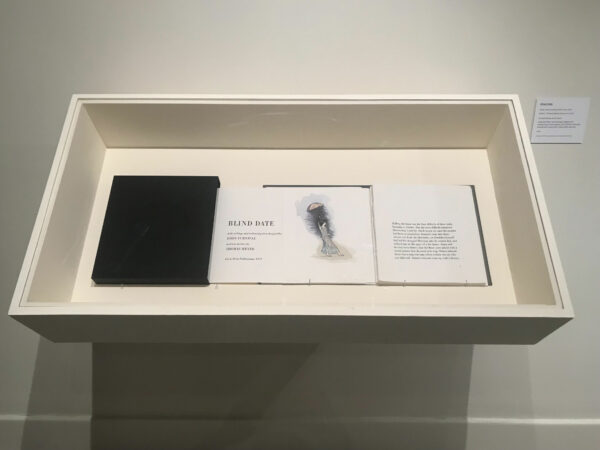
“Blind Date” a book on view from the permanent collection of the Grace Museum. Photo by Billi London-Gray
Fine Art Limited Edition Artist Books from the Permanent Collection
The presentation of these beautifully crafted objects behind glazing testifies to the embrace of the book as fine art. The clearly labeled collaborations point to the transdisciplinarity nature of artist books. The focus on elegant, limited edition folios in this exhibition only hints at the incredible diversity of experimental approaches artists have brought to the practice of bookmaking since the innovations of Ruscha and Roth.
Simeen Farhat: Scripted
Farhat’s work emerges from the walls as vibrating tangles of calligraphy. She transforms text from poets, prophets, text messages and other sources into complex abstract forms, which she casts in resin and assembles in tilted, intersecting planes. Her compositions embody layers of meaning and incomprehensibility in our uses of language.
Viewing her work at the Grace, I performed this irony of seeking assurance from ambiguity. As my eye moved through each of her compositions, it lingered on moments of recognition, like the word “shape” or the letter “g.” But my brain struggled to extract forms with certainty. Finally, I stopped seeking specific shapes and focused instead on the elements of line, direction, space, density, and color, reading each sculpture as a sequence of expressive gestures competing for dominance. Perhaps this is one of Farhat’s points about language.
Cara Barer: Obsolescence
The formal beauty of Barer’s work is meditative. Many of her photographed sculptures resemble mandalas and vascular cross-sections afloat in negative space, inviting the viewer to become entranced by their labyrinthine swirls. Knowing each image is a view of a book the artist has altered, however, arouses the desire to connect these intricate designs with the book’s content. Searching for clues in the visible text reveals little more than a glimpse of “SMITH Jack” phone book listings. The obscuring of most of the books’ original content, as well as the absence of the actual altered-book sculptures, reinforces the exhibition’s titular theme.
Anna Mavromatis: Material Culture
Mavromatis presents an epic narrative about gender equality using altered books, artist books, printmaking, and textile design. The repeated forms of children’s dresses and aprons and the restricted palette of ecru backgrounds with cyanotype and sepia tones make this exhibition feel mawkish at first glance. Upon looking closely at the images and text in Mavromatis’ works, however, this feeling is upended. It’s clear that the artist is haunting these domestic forms with the unresolved tension of many generations of systemic problems in Western society.
Mavromatis creates richly textured compositions packed with meaningful references. Among the evocative combinations in this exhibition are images of suffragettes and recent protesters collaged with coffee filters into a dress form; books with English and Greek text folded to resemble architectural columns; and a quilt made from dictionary pages and portraits of overlooked but highly accomplished women. I walked out of the gallery energized by the stridency in Mavromatis’ work and impressed by her inventive techniques.
Spread between the two floors occupied by the above exhibitions are additional works from the museum’s permanent collection, interpreted under the title, A Shared Conversation: Art & Language. These include, among other objects, centuries-old illuminated manuscript pages, a very small Picasso print, and neon script by Linda Ridgeway.
As a book artist, book lover, and hopelessly obsessive nerd (the sort who completes New York Times crossword puzzles with a fountain pen), I gravitate toward artists who care about the nuances and possibilities of language. Although I’m disappointed by the lack of emergent media that could expand further on the idea of the book, these shows deliver diverse transformations of books and language, making the familiar strange and the strange familiar, true to their “conversation” premise.
These five exhibitions are all on view through September 17, 2022. The Grace Museum’s history galleries also feature both permanent and rotating exhibitions related to the history of Abilene and West Texas. The museum is located at 102 Cypress Street in Abilene and is open Tuesday through Saturday from 10 am to 5 pm.


